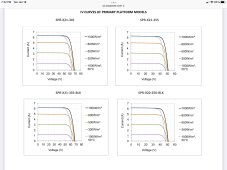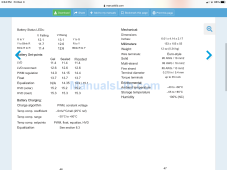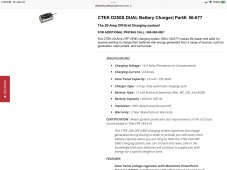My first questions involve whether a high voltage panel makes sense in a 12v camper setup…whether it will provide the performance boost the numbers promise, or just cause new problems I don’t have today. I know there is another thread that seemed to focus on this, but my post there got no response, so trying new thread instead.
I have an overly-complicated setup in my camper van, but any help appreciated.
today: 160w Carmanah/GoPower panel (see specs below) running through an older-style Morningstar ProStar 15m PWM controller. Actually, I have a switch on the positive wire so I can alternatively run the solar through a CTEK d250s (MPPT but with odd 23v input voltage limit and DC-DC capability). I use both controllers (one or the other for solar) but favor the Morningstar because it has a digital display which gives me some insight. I don’t know if the CTEK provides much better performance (maybe), but appreciate its ability to charge while driving…especially at night. I also have 2 separate AGM battery strings, so actually, if driving during daylight, I can charge both strings simultaneously (Morningstar for solar, CTEK from alternator). If parked longer term, I need to switch back and forth to get both strings charged. But I really like 2 strings, more on that further below.
I’m considering replacing the single 160w with a single SunPower 250w high voltage, which will necessitate MPPT such as Victron 100/20 (or larger???…please comment if that controller seems inadequate). The CTEK won’t work with this panel either (Voltage limit). The SunPower is surprisingly small, and fits my tight roof real estate; it’s specs are also below. The physical size is what attracted me to this panel. Adding panels to my existing doesn’t work so well with space allotted.
Will I get the expected power gains, or is something I haven’t considered going to be the new limiting factor? And/or are there going to be greater challenges / risks posed by the high voltage***. There is nothing magical about 250w for me, but on paper, it seems it would provide a meaningful bump in charge power, without causing a roof-top real-estate problem. I would be REALLY open to suggestion if there were another panel ~60” x ~31” with lower voltage, say a 36v panel, despite lower wattage.
250 is obviously 56% larger than 160. but given I mostly use PWM today, the percentage increase might be even higher. Keeping current 160wpanel, but getting a good MPPT controller might give an extra 25%, which might mean the bigger panel & MPPT might give close to 100% greater power…twice the power I can harvest today…or not. That is the (1st) question. Plus I’ve read there is a point of diminishing returns running high voltage into a 12v MPPT (I don’t know where that point is though). Plus I’ll still have the same issue with shading and am scratching head over how much wiring, fusing, and switching will need to be changed.
Also in the mix is upgrading ONE of the battery strings to LiFePO. One string for now. Battleborn claims I can keep using my current controllers (which do not have Lithium profiles, but probably not optimal). Of course, upgrading only one string complicates switching back & forth when I do upgrade to a controller with Li profile. If it matters, the “string I am upgrading to Li is 100ah. The other string (under the van floor) is 186ah AGM and the form factors needed and environmental considerations made upgrading that string a bit more of a challenge. In a perfect “greenfield” situation, with no budget limitations, I would have put LiFePO in the under-the-van location first, but I sprang for a single Battleborn when they had their Black Friday sale…and I doubt it would fit there. Besides that 186ah string still seems to work well (unlike the 100ah string). I don’t have the money to do everything
Attachments
I have an overly-complicated setup in my camper van, but any help appreciated.
today: 160w Carmanah/GoPower panel (see specs below) running through an older-style Morningstar ProStar 15m PWM controller. Actually, I have a switch on the positive wire so I can alternatively run the solar through a CTEK d250s (MPPT but with odd 23v input voltage limit and DC-DC capability). I use both controllers (one or the other for solar) but favor the Morningstar because it has a digital display which gives me some insight. I don’t know if the CTEK provides much better performance (maybe), but appreciate its ability to charge while driving…especially at night. I also have 2 separate AGM battery strings, so actually, if driving during daylight, I can charge both strings simultaneously (Morningstar for solar, CTEK from alternator). If parked longer term, I need to switch back and forth to get both strings charged. But I really like 2 strings, more on that further below.
I’m considering replacing the single 160w with a single SunPower 250w high voltage, which will necessitate MPPT such as Victron 100/20 (or larger???…please comment if that controller seems inadequate). The CTEK won’t work with this panel either (Voltage limit). The SunPower is surprisingly small, and fits my tight roof real estate; it’s specs are also below. The physical size is what attracted me to this panel. Adding panels to my existing doesn’t work so well with space allotted.
Will I get the expected power gains, or is something I haven’t considered going to be the new limiting factor? And/or are there going to be greater challenges / risks posed by the high voltage***. There is nothing magical about 250w for me, but on paper, it seems it would provide a meaningful bump in charge power, without causing a roof-top real-estate problem. I would be REALLY open to suggestion if there were another panel ~60” x ~31” with lower voltage, say a 36v panel, despite lower wattage.
250 is obviously 56% larger than 160. but given I mostly use PWM today, the percentage increase might be even higher. Keeping current 160wpanel, but getting a good MPPT controller might give an extra 25%, which might mean the bigger panel & MPPT might give close to 100% greater power…twice the power I can harvest today…or not. That is the (1st) question. Plus I’ve read there is a point of diminishing returns running high voltage into a 12v MPPT (I don’t know where that point is though). Plus I’ll still have the same issue with shading and am scratching head over how much wiring, fusing, and switching will need to be changed.
Also in the mix is upgrading ONE of the battery strings to LiFePO. One string for now. Battleborn claims I can keep using my current controllers (which do not have Lithium profiles, but probably not optimal). Of course, upgrading only one string complicates switching back & forth when I do upgrade to a controller with Li profile. If it matters, the “string I am upgrading to Li is 100ah. The other string (under the van floor) is 186ah AGM and the form factors needed and environmental considerations made upgrading that string a bit more of a challenge. In a perfect “greenfield” situation, with no budget limitations, I would have put LiFePO in the under-the-van location first, but I sprang for a single Battleborn when they had their Black Friday sale…and I doubt it would fit there. Besides that 186ah string still seems to work well (unlike the 100ah string). I don’t have the money to do everything
Attachments








